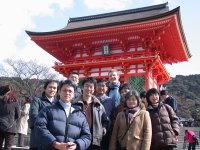 A couple weeks ago I went on the yearly departmental trip with other teachers from the English department at school. 9 of the 13 teachers ended up coming along for a weekend in Kyoto. Unfortunately, neither the Beach Boys Sensei nor the old guy who does kendo were able to make it. I promised them both before I would make up their part in drinking though. Fortunately, both the hilarious sarcastic teacher who helps with English club (the woman in glasses on the right) and the other younger teacher from Kendo (with the camera strapped around his neck and the leather jacket with the fur collar) were coming, so I knew I'd still have at least two people worth talking to.
A couple weeks ago I went on the yearly departmental trip with other teachers from the English department at school. 9 of the 13 teachers ended up coming along for a weekend in Kyoto. Unfortunately, neither the Beach Boys Sensei nor the old guy who does kendo were able to make it. I promised them both before I would make up their part in drinking though. Fortunately, both the hilarious sarcastic teacher who helps with English club (the woman in glasses on the right) and the other younger teacher from Kendo (with the camera strapped around his neck and the leather jacket with the fur collar) were coming, so I knew I'd still have at least two people worth talking to.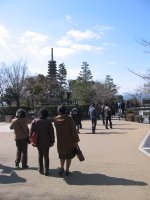 We were supposed to meet at the train station early Saturday morning to catch a 9 am bullet train, to arrive in Kyoto around 10:15. Since two of the English teachers live in the same apartment building as me, I caught a ride with them to the station. We meet up with the other teachers, sit around waiting for a couple stragglers and then get on our train. It's an hour and 15 minute train ride and they're talking about school about 15 minutes into it, which means they've exhausted all other outlets of conversation. We have reserved seats in one compartment; 10 teachers means we take up an entire two rows of seats, with two sets of three on one side and two on the other. In what would later prove to be a common theme for the trip, the three women sit on the side with the four seats, and the six guys sit on the other side. That is, some automatic sex segregation. In the picture you can see later that day how this played out on the streets, with the women trailing behind and the men rushing off ahead. (Kind of reminded me of the family hikes of my youth)
We were supposed to meet at the train station early Saturday morning to catch a 9 am bullet train, to arrive in Kyoto around 10:15. Since two of the English teachers live in the same apartment building as me, I caught a ride with them to the station. We meet up with the other teachers, sit around waiting for a couple stragglers and then get on our train. It's an hour and 15 minute train ride and they're talking about school about 15 minutes into it, which means they've exhausted all other outlets of conversation. We have reserved seats in one compartment; 10 teachers means we take up an entire two rows of seats, with two sets of three on one side and two on the other. In what would later prove to be a common theme for the trip, the three women sit on the side with the four seats, and the six guys sit on the other side. That is, some automatic sex segregation. In the picture you can see later that day how this played out on the streets, with the women trailing behind and the men rushing off ahead. (Kind of reminded me of the family hikes of my youth)Arriving at the station, I watch as the teacher ostensibly in charge of this expedition immediately takes us out the wrong exit. I know we're not at the right one, since it exits into a massive shopping complex and we're instead standing in front of a convenience store. Since I'm the youngest person on the trip and the newest teacher in general, I'm trying to let this kind of thing go in the interest of respect. However, after they proceed to spend about 10 minutes as a group trying to decide the best course of action, finally I just tell everyone to follow me since I've been here several times and know exactly where to go. Once I start walking, everyone falls in line and I lead them like duckling through the station and to our hotel. This is another theme of the trip; the teachers dissolving in the face of group decisions into an amorphous, directionless mass until someone - namely, me - prompts direct action. I assumed one of the other teachers would be sort of designated group leader, but since they're all off duty so to speak, pretty much everyone just wants to be led around.
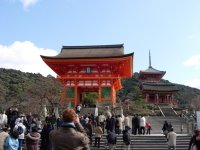 We drop off our bags at the hotel and head off to Kiyomizu Temple, a complex dating back to the late 8th century and one of the main sights of the city. (A little more info here) The other teachers, excited to show the place off to me, are disappointed to hear that this is the 4th time I've been to it; I've actually been there more times than anyone else in our group. Still, it's an impressive building no matter how many times one sees it, and it is a beautiful clear day in Kyoto. There are, as always, a lot of people there as well - both Japanese and foreign - but our group is special to be a big Japanese group with a single foreigner. Later, looking at some of the other teacher's pictures - like this one here - I was puzzled by how many in which I appear in the foreground. At first I wondered if I weren't just so tall I was inadvertently blocking all the shorter teachers shots. In retrospect, the teacher was deliberately putting me into the frame to make the picture that much more exotic. Of course, I certainly am not complaining about this.
We drop off our bags at the hotel and head off to Kiyomizu Temple, a complex dating back to the late 8th century and one of the main sights of the city. (A little more info here) The other teachers, excited to show the place off to me, are disappointed to hear that this is the 4th time I've been to it; I've actually been there more times than anyone else in our group. Still, it's an impressive building no matter how many times one sees it, and it is a beautiful clear day in Kyoto. There are, as always, a lot of people there as well - both Japanese and foreign - but our group is special to be a big Japanese group with a single foreigner. Later, looking at some of the other teacher's pictures - like this one here - I was puzzled by how many in which I appear in the foreground. At first I wondered if I weren't just so tall I was inadvertently blocking all the shorter teachers shots. In retrospect, the teacher was deliberately putting me into the frame to make the picture that much more exotic. Of course, I certainly am not complaining about this.Inside the grounds of the temple is a small shrine, Jishu, dedicated to a god of love and matchmaking. As such, it's crammed with young women at all times buying charms of all kinds; to meet people, to stay with people, to have kids, to have healthy kids, to have your kids meet people, to have your kids stay with people, to have you kids have kids...you get the idea. They sell charms of a sort at pretty much every shrine and temple in Japan, usually just at stall inside. At popular places like Jishu or Kiyomizu though, it reaches such a ridiculous level that it seems people are more there to buy souvenirs than actually see the place itself. That is, they become popular as souvenir shops selling goods associated with the place above the place itself.
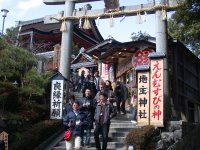 Also at the Jishu Shrine are two stones at a distance of perhaps 50 feet. Legend has it that if a person can cross between the two stones, walking with his or her eyes closed, his or her's wish in love will come true. Knowing that one of the teachers - the guy who loves to curse - is in his early thirties and unmarried, I started joking that he should do it. As he didn't immediately decline, I started pushing more, getting the other guy teachers to join in with some quality peer-pressure as we chanted "Do it, do it, do it!" He eventually flushed red, wussed out, and ran away down the stairs, with me and the other guys laughing behind him.
Also at the Jishu Shrine are two stones at a distance of perhaps 50 feet. Legend has it that if a person can cross between the two stones, walking with his or her eyes closed, his or her's wish in love will come true. Knowing that one of the teachers - the guy who loves to curse - is in his early thirties and unmarried, I started joking that he should do it. As he didn't immediately decline, I started pushing more, getting the other guy teachers to join in with some quality peer-pressure as we chanted "Do it, do it, do it!" He eventually flushed red, wussed out, and ran away down the stairs, with me and the other guys laughing behind him. We walked through the grounds until we reached the most impressive part of the temple: the stage. Suspended over the valley below through a series of wooden pillars, it offers a panoramic view of the forest behind, gardens below and city beyond in the distance. I reminisced about when my brother visited and basically assaulted two Japanese girls here. (When they asked him to take a picture of them, he insisted instead that we all take one together, leading to one hilariously awkward shot where they clearly don't understand what is going on, and that really captures the deer in the headlights quality of their reaction to Matt) Anyhow, in about the same spot, I snapped this shot of the three female teachers. On the right is the funny teacher, the one in the middle is your stereotypical sweet old Japanese grandma, and the one on the left looks like Yoda and, I discovered on this trip, is really devoid of any discernible personality. Actually, I think Maiko made a much more biting, though uncharacteristically insensitive insult when she saw this picture, exclaiming, "That teacher dresses like a homeless woman!"
We walked through the grounds until we reached the most impressive part of the temple: the stage. Suspended over the valley below through a series of wooden pillars, it offers a panoramic view of the forest behind, gardens below and city beyond in the distance. I reminisced about when my brother visited and basically assaulted two Japanese girls here. (When they asked him to take a picture of them, he insisted instead that we all take one together, leading to one hilariously awkward shot where they clearly don't understand what is going on, and that really captures the deer in the headlights quality of their reaction to Matt) Anyhow, in about the same spot, I snapped this shot of the three female teachers. On the right is the funny teacher, the one in the middle is your stereotypical sweet old Japanese grandma, and the one on the left looks like Yoda and, I discovered on this trip, is really devoid of any discernible personality. Actually, I think Maiko made a much more biting, though uncharacteristically insensitive insult when she saw this picture, exclaiming, "That teacher dresses like a homeless woman!"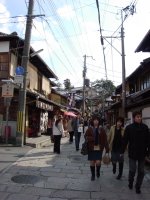 After walking out from the temple, we headed down a series of backstreets lined with shops. Whenever Japanese people go anywhere, they have an obligation to buy a souvenir for everyone they know or might conceivably meet in the near future, so we had to buy some Kyoto stuff. Luckily, every city or even small town in Japan has at least one thing it is "famous" for (Incidentally, Hamamatsu is famous for its eel and a candy called "Eel Pies" that doesn't really contain eel) that is sold all over the place. I couldn't believe that we'd been in Kyoto for less than two hours and were already buying souvenirs in preparation for the trip back.
After walking out from the temple, we headed down a series of backstreets lined with shops. Whenever Japanese people go anywhere, they have an obligation to buy a souvenir for everyone they know or might conceivably meet in the near future, so we had to buy some Kyoto stuff. Luckily, every city or even small town in Japan has at least one thing it is "famous" for (Incidentally, Hamamatsu is famous for its eel and a candy called "Eel Pies" that doesn't really contain eel) that is sold all over the place. I couldn't believe that we'd been in Kyoto for less than two hours and were already buying souvenirs in preparation for the trip back.That being said, it was an interesting area with a very traditional "Kyoto" feeling to it, both in the architecture, the small shops and restaurants, and the sort of feeling of walking on narrow winding lanes. Kyoto, despite the evocative nature of the name to us foreigners, is in reality a rather large, modern city, and the large, modern parts of it are pretty boring, if not outright ugly. It's kind of upsetting at first to see, but the Kyoto that we want to see is still extant, just a little harder to find.
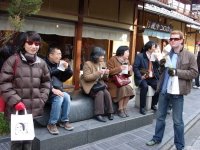 After this, we stopped for a break and had some snacks. Some of us, as you can see in the picture, sat down all hunched over with our legs pulled in like little children. We decided to break up for the time being and meet up again later for dinner. I went with the guys, who were going to walk through the city and see some sights on their way to visit Kyoto University, I suppose as a show of support for some of their students taking the entrance exams later that month.
After this, we stopped for a break and had some snacks. Some of us, as you can see in the picture, sat down all hunched over with our legs pulled in like little children. We decided to break up for the time being and meet up again later for dinner. I went with the guys, who were going to walk through the city and see some sights on their way to visit Kyoto University, I suppose as a show of support for some of their students taking the entrance exams later that month.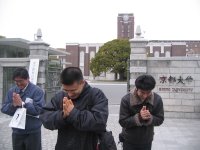 So we ended up on a long and largely uneventful trek through the city in which they got lost several more times and I had to either lead or ask for directions since they didn't want to talk to strangers. When we arrived at Kyoto University, we were so tired from walking that we never got any farther than the tourist information center. Since it had a video tour of the campus, we just chose to watch that instead of actually doing any more moving for a while. I was happy with this because I had visited Kyoto U before last time I was in Kyoto, and found it just as drab the second time as the first. On our way out, three of the teachers kind of bowed at the entrance and made a short prayer for their student's success. I insisted they do it again so I could take a picture, "to show the students later to prove you went." Then I made them hold the pose for about a minute, continuously saying, "Wait wait, one more second!" each time they tried to stop bowing. Notice that they're laughing in the picture, but, importantly, still bowing.
So we ended up on a long and largely uneventful trek through the city in which they got lost several more times and I had to either lead or ask for directions since they didn't want to talk to strangers. When we arrived at Kyoto University, we were so tired from walking that we never got any farther than the tourist information center. Since it had a video tour of the campus, we just chose to watch that instead of actually doing any more moving for a while. I was happy with this because I had visited Kyoto U before last time I was in Kyoto, and found it just as drab the second time as the first. On our way out, three of the teachers kind of bowed at the entrance and made a short prayer for their student's success. I insisted they do it again so I could take a picture, "to show the students later to prove you went." Then I made them hold the pose for about a minute, continuously saying, "Wait wait, one more second!" each time they tried to stop bowing. Notice that they're laughing in the picture, but, importantly, still bowing. We met up again for dinner at a very nice restaurant along the Kamo River, the ancient eastern boundary of the capital, from which the traditional road east to Tokyo, the Tokaido, began. I was, of course, mostly affecting a signature pensive-style pose for this photograph, but also actually was thinking a bit. The Kamo River is one of those places that figures prominently in so many books, plays, and historical accounts of Japan that I've read, that it is always both exciting and profoundly strange to suddenly be standing next to it. Somehow, when I read in Kabuki plays about the legendary battle between Benkei and Yoshitsune on the bridge over the river, it seemed totally outside my world. It was a world I could not imagine I would ever see, and in that sense, one that never did really exist. This is quite different than reading Dickens or Hemingway stories set in London or Paris; Europe feels quite immediate and close, and even somehow these works are tinged with a feeling of resignation in that my life will almost inevitably take me through those places. Standing on the banks of the Kamo River, or in the temples built by Hideyoshi, or on a forest path through the Japanese Alps next to two waterfalls that figures prominently in the story of Musashi, it seems almost comically unreal that I am here.
We met up again for dinner at a very nice restaurant along the Kamo River, the ancient eastern boundary of the capital, from which the traditional road east to Tokyo, the Tokaido, began. I was, of course, mostly affecting a signature pensive-style pose for this photograph, but also actually was thinking a bit. The Kamo River is one of those places that figures prominently in so many books, plays, and historical accounts of Japan that I've read, that it is always both exciting and profoundly strange to suddenly be standing next to it. Somehow, when I read in Kabuki plays about the legendary battle between Benkei and Yoshitsune on the bridge over the river, it seemed totally outside my world. It was a world I could not imagine I would ever see, and in that sense, one that never did really exist. This is quite different than reading Dickens or Hemingway stories set in London or Paris; Europe feels quite immediate and close, and even somehow these works are tinged with a feeling of resignation in that my life will almost inevitably take me through those places. Standing on the banks of the Kamo River, or in the temples built by Hideyoshi, or on a forest path through the Japanese Alps next to two waterfalls that figures prominently in the story of Musashi, it seems almost comically unreal that I am here.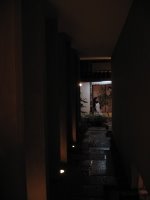 Anyway, the restaurant was basically just a single home perched on the river. We sat along a single long table looking out and were served a series of dishes in a distinctly Kyoto style of cuisine called kaiseki and waited on diligently by two little old women. Had a great dinner; drinking and chatting along with the other teachers as we waited for the next dish to be brought out. After a series of immaculately prepared dishes, came my most feared Japanese concoction: the foul chawanmushi.
Anyway, the restaurant was basically just a single home perched on the river. We sat along a single long table looking out and were served a series of dishes in a distinctly Kyoto style of cuisine called kaiseki and waited on diligently by two little old women. Had a great dinner; drinking and chatting along with the other teachers as we waited for the next dish to be brought out. After a series of immaculately prepared dishes, came my most feared Japanese concoction: the foul chawanmushi.  This "savory egg custard" is like a warm, sour egg pudding, with a disgustingly slippery texture. Since I had told a couple teachers that I hated chawanmushi, they were all really hoping it would be served during dinner, just to spite me. Usually, I wouldn't touch the stuff, but since I was paying more than a hundred dollars for the dinner, I felt obligated to choke every part of it down. People here seem to consider this dish a delicacy, but as you can see from the picture a teacher snapped of me eating, I do not. When it was put in front of me, they could not contain their glee, jibbing me in the ribs, snapping shots of me, and actually taking a video of me eating. Bastards.
This "savory egg custard" is like a warm, sour egg pudding, with a disgustingly slippery texture. Since I had told a couple teachers that I hated chawanmushi, they were all really hoping it would be served during dinner, just to spite me. Usually, I wouldn't touch the stuff, but since I was paying more than a hundred dollars for the dinner, I felt obligated to choke every part of it down. People here seem to consider this dish a delicacy, but as you can see from the picture a teacher snapped of me eating, I do not. When it was put in front of me, they could not contain their glee, jibbing me in the ribs, snapping shots of me, and actually taking a video of me eating. Bastards.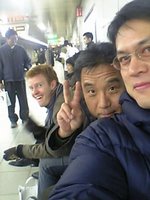 After dinner, most of the teachers packed it in for the night, but a few others and I went out for some more drinks. Walking around downtown with just a few of them, looking for a bar, laughing at their bewilderment with all the lights and people out in the city, I suddenly became aware of how different they were from Tokyo people. Nice people all, to be sure, but just as assuredly they're from the sticks. When I walked around the campus of Kyoto University with the teachers, they marvelled at the sheer size of this campus that is smaller than Waseda and maybe a fourth that of UCLA. Almost all of them were born and all of them grew up in this prefecture, and they all came back here to work after college - sometimes even at the same high schools they attended. It's come up a lot here actually, when I start talking to students, teachers, or just friends around here about Japan, I realize that I've been to more places in their country than they have. It's amusing to say, but I'm a more worldly person in the Japanese sense than the other Japanese here!
After dinner, most of the teachers packed it in for the night, but a few others and I went out for some more drinks. Walking around downtown with just a few of them, looking for a bar, laughing at their bewilderment with all the lights and people out in the city, I suddenly became aware of how different they were from Tokyo people. Nice people all, to be sure, but just as assuredly they're from the sticks. When I walked around the campus of Kyoto University with the teachers, they marvelled at the sheer size of this campus that is smaller than Waseda and maybe a fourth that of UCLA. Almost all of them were born and all of them grew up in this prefecture, and they all came back here to work after college - sometimes even at the same high schools they attended. It's come up a lot here actually, when I start talking to students, teachers, or just friends around here about Japan, I realize that I've been to more places in their country than they have. It's amusing to say, but I'm a more worldly person in the Japanese sense than the other Japanese here!
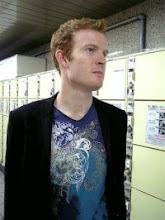
4 comments:
I had that egg stuff at the temple in Koya-san, except I was so fucking starving that I ate it with relish.
d'angelo sensei looks so cute! why dont u post more maiko pix?
You're right about Shelley, that was a mistake on my part.
My point was that Hinduism and Buddhism are not known for the sort of intolerance that followers of Islam or, of course, Christianity have proved themselves capable of in the past. However, I would not make such a broad generalization about Islam as a force of intolerance at large; one needs just to look at the news to see the level-headed, open-minded way in which Islam civilization regularly influences the world.
Dude that Yoda lady is so cool, whats her deal...
Post a Comment